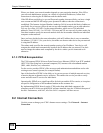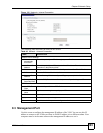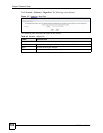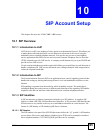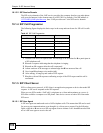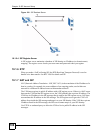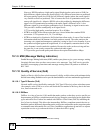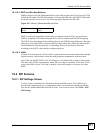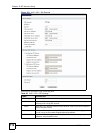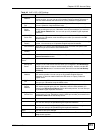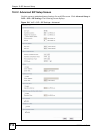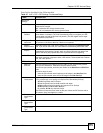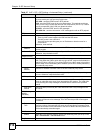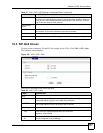
Chapter 10 SIP Account Setup
V300 User’s Guide
110
However, DPCM produces a high quality signal (high signal-to-noise ratio or SNR) for
high difference signals (where the actual signal is very different from what was predicted)
but a poor quality signal (low SNR) for low difference signals (where the actual signal is
very similar to what was predicted). This is because the level of quantization noise is the
same at all signal levels. Adaptive DPCM solves this problem by adapting the difference
signal’s level of quantization according to the audio signal’s difference level. A low
difference signal is given a higher quantization level, increasing its signal-to-noise ratio.
This provides a similar sound quality at all signal levels.
G.723 provides high quality sound and requires 20 or 40 kbps.
• G. 7 2 6 is an ADPCM waveform codec that uses a lower bitrate than standard PCM
conversion. G.726 operates at 16, 24, 32 or 40 kbps.
• G. 7 2 9 is an Analysis-by-Synthesis (AbS) hybrid waveform codec. It uses a filter based on
information about how the human vocal tract produces sounds. The codec analyzes the
incoming voice signal and attempts to synthesize it using its list of voice elements. It tests
the synthesized signal against the original and, if it is acceptable, transmits details of the
voice elements it used to make the synthesis. Because the codec at the receiving end has
the same list, it can exactly recreate the synthesized audio signal.
G.729 provides good sound quality and reduces the required bandwidth to 8kbps.
10.1.9 MWI (Message Waiting Indication)
Enable Message Waiting Indication (MWI) enables your phone to give you a message–waiting
(beeping) dial tone when you have one or more voice messages. Your VoIP service provider
must have a messaging system that sends message-waiting-status SIP packets as defined in
RFC 3842.
10.1.10 Quality of Service (QoS)
Quality of Service (QoS) refers to both a network's ability to deliver data with minimum delay
and the networking methods used to provide bandwidth for real-time multimedia applications.
10.1.10.1 Type Of Service (ToS)
Network traffic can be classified by setting the ToS (Type Of Service) values at the data source
(for example, at the V300) so a server can decide the best method of delivery, that is the least
cost, fastest route and so on.
10.1.10.2 DiffServ
DiffServ is a class of service (CoS) model that marks packets so that they receive specific per-
hop treatment at DiffServ-compliant network devices along the route based on the application
types and traffic flow. Packets are marked with DiffServ Code Points (DSCPs) indicating the
level of service desired. This allows the intermediary DiffServ-compliant network devices to
handle the packets differently depending on the code points without the need to negotiate paths
or remember state information for every flow. In addition, applications do not have to request
a particular service or give advanced notice of where the traffic is going.
1
1. The V300 does not support DiffServ at the time of writing.



